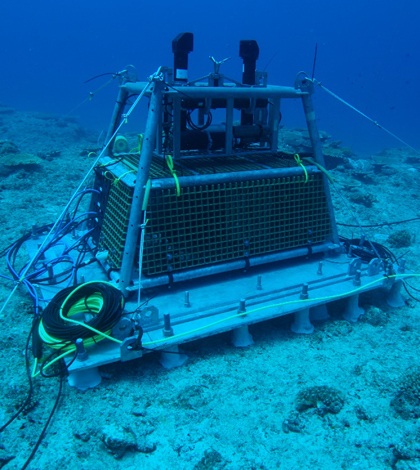New seafloor observatory tracks the carbon cycle in Kuroshio Current

The OceanCube seafloor observatory's main node (Credit: OIST)
The strong pull of the Kuroshio Current makes instrument deployment a challenge, as 50 million tons of water passes the southeast coast of Japan each second.
“Divers had to be careful not to be swept away,” said Scott Gallager, Woods Hole Oceanographic Institution associate scientist and principal investigator for the newly installed OceanCube Observatory System.
Scientists from the United States and Japan built the observatory right in the middle of the powerful Kuroshio Current to monitor a 200,000 cubic meter volume of water. Data collected in the OceanCube will eventually be compared to another ocean observatory in the works down current. “The design of the OceanCube is specific to understanding the flux of materials through a defined volume of water,” Gallager said.
The team from Woods Hole Oceanographic Institution, Okinawa Institute of Science and Technology Graduate University and Okinawa Churaumi Aquarium weathered the current and a pair of typhoons to install their new observatory off Japan’s Motobu Peninsula. It took three weeks and one diver was swept away. Luckily a fishing boat captain pulled him out down current.
OceanCube is the second iteration of an in-situ ocean observatory built to help researchers get a quantitative view of how carbon fluctuates through the ocean via biology and various current movements. The first undersea ocean observatory was built off a Panamanian Island in the Pacific Ocean.
The Kuroshio Current often carries cold upwelled water, which is rich in nutrients and low in oxygen and pH. Internal waves travel within the current, further stirring the water and increasing production as it hits Japan’s narrow continental shelf.

A rendering of the Kuroshio Current (Credit: NASA/Goddard Space Flight Center Scientific Visualization Studio)
Japan’s OceanCube is located in a biologically rich section of the Pacific. The site is thriving with a multitude of marine species, said Amber York, a WHOI research associate who works on the project. Sea turtles are particularly prolific there, along with a vast number of fish she is working to identify and catalogue in a species count.
Gallager said the thriving ecosystem, living amidst low pH and low oxygen upwelled water, means that organisms must have developed strategies for dealing with acidified water well before ocean acidification became an issue. That makes the site a natural ground to study marine life’s adaptability to ocean acidification
Most species of coral in the area are recovering from a widespread bleaching event that occurred in the 1980s. Gallager said the observatory will be there to watch coral recover. “As the coral begins to rebound and grow back, the communities of fish and benthic organisms will change also,” he said. “How the trajectory of these rebounding communities is impacted by climate change and ocean acidification is a major question we are addressing.”
Carbon enters the water column as carbon dioxide diffusing through the air-sea interface. The carbon is transformed into calcium carbonate, most of which the researchers presume ends up on the seafloor. They hope to measure calcium carbonate flux with the new seafloor observatory and use the figures to gain a better understanding of carbon cycling in the ocean.
The OceanCube monitors a volume of water that spans 100 meters per side by 20 meters deep. The observatory includes a variety of habitats, such as open water, rocky seafloor and coral reefs. Gallager said the researchers were careful to build the cube with a fixed volume in mind so they could calculate carbon concentrations and flux to the seafloor.
Temperature strings are used on the corners of the OceanCube. Acoustic Doppler current profilers at each corner measure wave amplitude, period and velocity. ADCPs also measure magnitude and direction of the current.

The OceanCube instruments before installation (Credit: OITS)
At the center of the observatory, sensors measure the water’s chemical and biological properties, such as temperature, salinity, pressure, pCO2, pH, turbidity and chlorophyll. There are also sensors measuring organic and inorganic particulate in the water. Light sensors measure photosynthetically active radiation.
A special Continuous Plankton Imaging and Classification Sensor counts and classifies different species of plankton floating through the current. York said she is working on a similar setup for fish. “The next step is to develop automated machine vision classifiers to identify the fish automatically just as we do for the plankton. That will be a major advance in ocean observatories,” she said.
Two fixed stereo cameras and a pan and tilt camera, controlled from the OceanCube website, show sea life in real time around the observatory. “We can look at the biology that happens at the site and correlate it with environmental parameters we are measuring,” said York.
Data gathered by the OceanCube is logged in the Okinawa Churaumi Aquarium.
Now that the observatory is up and running, researchers look forward to sharing data with the scientific community.
The third ocean observatory will be built down current at Oshima Island, 100 kilometers south of Tokyo. The researchers will then compare the two sites and measure transport of biological and inorganic carbon.
Top image: The OceanCube seafloor observatory’s main node (Credit: OIST)




0 comments